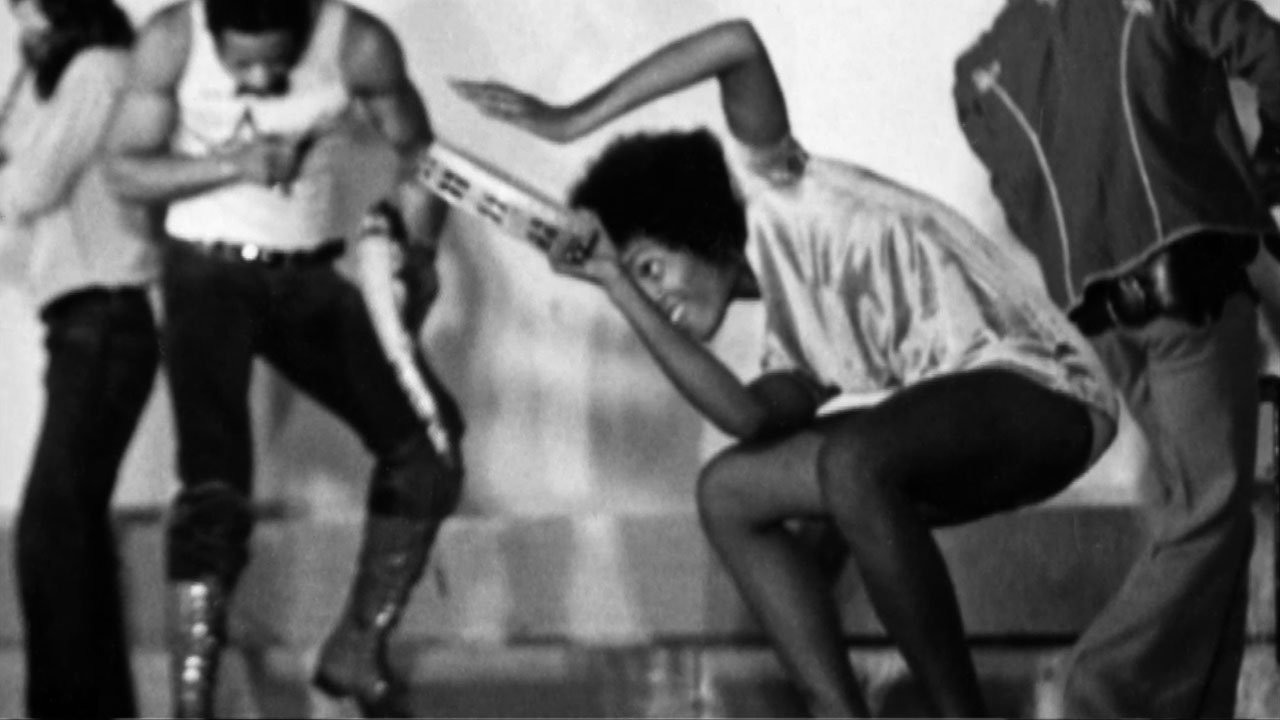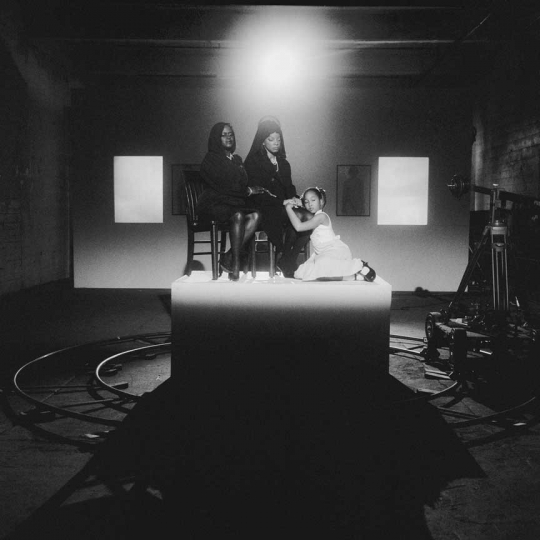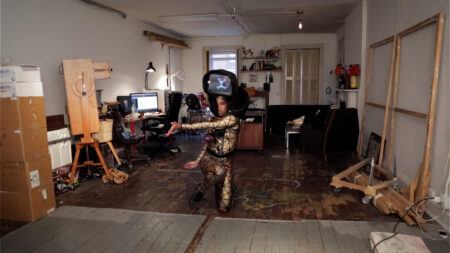Interview
Dance, Bodies, and Aging

Production still from the Art in the Twenty-First Century Season 5 episode, Compassion. © Art21, Inc. 2009.
On the eve of the unveiling of the artist’s 2008 project, Constructing History: A Requiem to Mark the Moment, at the Savannah College of Art and Design in Atlanta, Carrie Mae Weems discusses her background in dance, the role of other women’s bodies in her work, and the ongoing performative thread in her photographs and films.
WEEMS: What’s the back-story? I moved away from home when I was sixteen…and my best friend was a dancer. We’re still in contact today and she works with me on some of my film projects, the most recent one in Atlanta and the one in Rome. She had also left home early, from a middle class German-Jewish family. I was from this working class black family, but we really hit it off and became best friends and we traveled a bit together. We moved to San Francisco together, for instance.
I had been interested in dance and theater to a certain extent. I wasn’t really so interested in dance, I just knew how to dance really well. I had a really, I think, deep sense of my body from a very early age. People were always inviting me to dance, always inviting me to join their companies, and so I went to San Francisco with my girlfriend [in 1970] and started dancing with the famous and extraordinary Anna Halprin. I was in Anna’s company for I suppose, maybe a year or two…experimenting with very deep parts of dance and ideas about dance. Anna was really interested in ideas about peace and using dance as a way to bridge different cultures together as a vehicle for multicultural expression. But this was of course when multiculturalism wasn’t used as a concept.
I loved dancing but I didn’t know what choreography was; I didn’t know what one could really do with dance. I had been more interested really in the visual arts. I wasn’t sure what kind of artist I would be. I knew that it was the visual arts that somehow would be more my calling. I sort of stumbled into photography. I had a boyfriend who was doing photography and film, and he would film all of our parties, happenings, rallies, and demonstrations. We were all radicals living in San Francisco. He introduced me to photography.
ART21: What years were those?
WEEMS: I suppose I got my first camera maybe in 1971–1972. I’ve been doing this a long, long time.
ART21: Amazing story about Halprin.
WEEMS: It really was. It was a very interesting world that I was traveling in. It was through Rana Halprin, Anna’s daughter, that I was first introduced to flamenco. She was a young flamenco dancer. In our apartment we had a flamenco stage, and these wonderful men and women would come visit us from Seville and stay in our apartment and we would talk about jazz and blues and gypsy music. It was then that I started to see the first inkling of this relationship between blues music and gypsy flamenco music. I thought that one day I would go to Seville and look at it more closely, and now thirty years later I’m just beginning this project of looking at blues and flamenco, and ideas about dance and movement. I’m very excited about this sort of next phase of work.
ART21: How long before the work is shown?
WEEMS: A year. The show is going to open next October [2009] in Seville and then travel, so the work has got to be done by then. I thought, well then, in the next few weeks, I’ll go to Spain. There’s a huge festival of flamenco that begins in the next month and it lasts for a month. I think that one really has to use the body to understand certain kinds of things. And so I decided that the first thing to do would be to study flamenco. Just to go to Spain and to study flamenco.
Often when people see me move, when dancers see me move, they immediately know that I’ve studied dance. They know that I come from a certain kind of background. Other people are very curious about it, they don’t quite know what to make of it, but they know that they’re seeing somebody walk in a way that they don’t normally see them walk.
A part of my work that interests me most and that I’ve come to understand more in recent years is that it’s very important for me to really use this body as a barometer of a certain kind of knowledge—to take the personal risk of exposing my own body in a certain kind of way. I can’t ask anybody else to do something that I don’t do first myself. I have to know what it means to be naked and exposed first, and then I can ask you, perhaps, to participate with me. But I have to know the depths of the vulnerability first. And so most of the work really is very performative and that is true almost from the very beginning.
I was just reading something that Cartier-Bresson said…there is a great deal one has to be sensitive to. But even more…one has to sort of seize the power that’s within the medium itself. And in doing that then you have to put aside certain kinds of sentimentalities in order to get the work done—tough work done sensitively. That idea, I think, functions well with me when I’m working and the way that I ask people to involve themselves, if I ask others to be involved.
ART21: Do you remove yourself?
WEEMS: I’ve had these wonderful stand-ins.
ART21: Tell me about them.
WEEMS: In the recent piece, A Requiem To Mark the Moment [2008] I knew that it was going to be really demanding and I wanted to concentrate on building the image and allowing myself the room to do that without trying to wear six different hats. I just didn’t want to tax myself in that way. What was important was to find the appropriate stand-ins that could physically deliver in the way that I thought might be important and necessary. And for the first time I discovered another body and a type that understood gesture and movement in a certain way—and there are literally photographs that I have where I couldn’t quite tell if it was she or I standing in that photograph. It’s like, “Oh, wait a minute, is that me?” It was really wonderful to discover that, yes, actually I can have somebody stand in for not just me but for the archetype that I’m really trying to get across.

Carrie Mae Weems. The Assassination of Medgar, Malcolm, and Martin, 2008. Archival pigment print, 61 × 51 inches. © Carrie Mae Weems. Courtesy of Jack Shainman Gallery, New York.
I think that I’ve been a wonderful archetype to stand in for black women, and for certain kinds of women, certain kinds of mature women, and women in charge of their sexuality and in charge of or aware of their vulnerability, asking questions of themselves, their bodies, their desires, and urges. I’ve been very aware of those things and I know how to do that. I know how to speak to that. I have had years of practice. But I needed somebody that could do that along with me so that I could retreat for a moment and take care of some other kind of work.
I did a cast call [in Atlanta] and all these people showed up. It was scheduled to start at six and the first person in line was a woman named Adriana. Adriana came in with her little suit on and her bio and resume. She put it on the table and she turned to me and said, “I just want you to know that I’m your girl and I look forward to working with you.” And I thought, who is this? She’s got to go. I’m not working with this woman. She walked out and I just laughed and almost tore up her photograph the moment she walked out. I thought, the audacity. “I’m your girl!” Who the hell do you think you are? And sure enough a couple of days later, I’m putting together the first call for work, and I turn over her photograph, and I put it back on the table. Then, I flipped it back over and I thought, wait a minute—this woman was the first woman in line, right? Stood there for an hour and a half. I think that you deserve to pick up the phone and call her and that she deserves that. Let’s see what she can do. And every time I turned around, whether she was called or not called, she was there.
She taught me one of the greatest lessons ever: that you never judge a book by its cover, that you have patience, that you have grace, and that being there counts almost more than anything else. Because when stuff hit the fan, I could look around and there she was, whether I’d called her or not, she was sitting there in that chair, waiting. “Is there another opportunity for me? Is there anything you need me to do? If so, I’m here.” It was unbelievable. Just an extraordinary, extraordinary presence, a real throw down kind of girl who wants to make sure that you get it done and you get it done right, and is malleable.
ART21: Is she in the video or photographs?
WEEMS: She’s in both. She plays the role of Coretta Scott King. She’s in the Kennedy assassination where she’s driving the car. There are several other images that she’s in as well that actually aren’t being used yet in the takes that we’ve done for Requiem but will be used for other kinds of projects, I think, in the future. But she was really quite special and very important to me and was a really lovely person to work with. When you find that kind of person you don’t want to let them go. It was like there was another sister in the room who got it, who really got it, and knew how to be there.

Carrie Mae Weems. Mourning, 2008. Archival pigment print; 61 × 51 inches. © Carrie Mae Weems. Courtesy of Jack Shainman Gallery, New York.
I think there’s something else that’s really important to look at—I’m getting older. I think about this question of desirability, of being looked at. Who wants to look at this fifty-five year-old woman? Who really wants to look at that? How much of myself do I need to expose at fifty-five, as opposed when I was thirty-five? What are the risks that one takes at fifty-five that you don’t take at thirty-five because the game has changed, the world has changed, you’ve changed. Putting yourself through certain kinds of paces has changed. Do I need to do that anymore? I’m not really sure—sometimes yes, sometimes no. This raises a very deep question about mature women and about how one looks at mature women. I think that recently there was a part of me that for a moment felt very frayed and very vulnerable about revealing myself, of showing myself, and also concerned about who would be interested in looking, because I’m making work that I’m hoping other people will look at, that I don’t want people to turn away from. Will people turn away from me? Am I not the thing that causes them to look?
If we use beauty as the crutch, and I think that we often do as a sort of gateway to exploring other kinds of issues, then I felt as though I was beginning to bump up against that wall in trying to figure out an authentic way (not a clever way, but an authentic way) of getting around that. And so some of the work that I’m working on right now looks at just this idea of looking at older women in their sense of self, desirability, desire, their sense of compassion, but really looking at this aging body in a way that for the most part I don’t think really gets looked at, examined, pictured, and imaged very often. Maybe that’s starting to change but I can’t think of anything right off the top.
It’s sort of like thinking about Eleanor Antin playing Antinova. I notice in this work (that she’s also been doing for a long time) that performative element where she steps in, where she allows her body, this beautiful form, to be molded and shaped. Clearly, there was a joy and an excitement in using her own body. I think it raises very interesting questions for women. I think, in fact, that this is sort of the same, right? Suddenly Eleanor has stepped out of the frame for probably the same kinds of reasons. First of all, there is just the drama of orchestrating other people, constructing the set, and then trying to be in it, too. Do you really need to be there? But I think the question of ageism raises its head too in this work that we’re doing. I think that it’s almost unavoidable for women in this country, for most countries, not to have to deal with it, since ageism is such a huge part of what happens to all of us, right? So women just get old and men get graceful or something like that. I can’t remember what the saying is, but you know what I mean.



